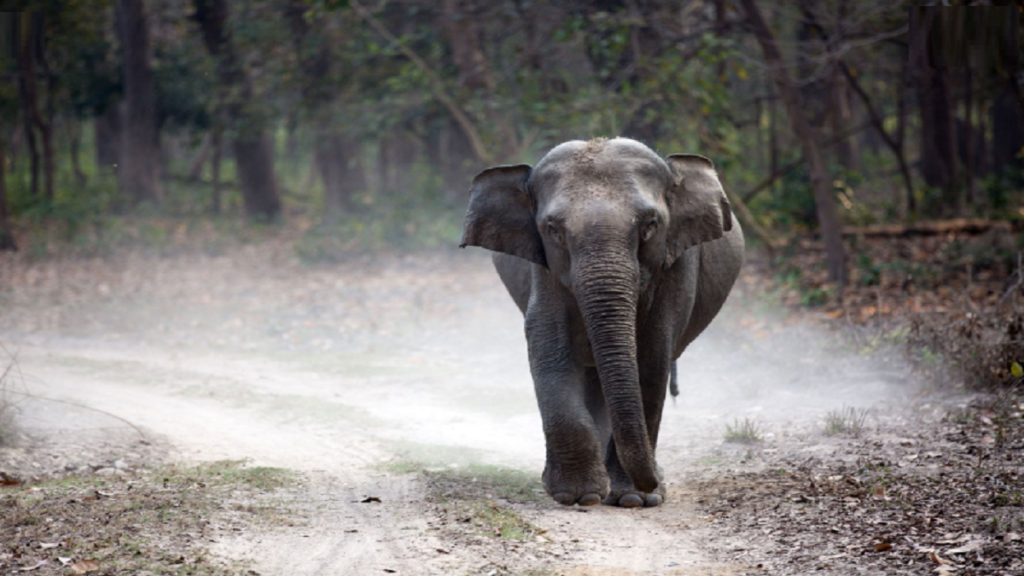In a saddening incident in Tripura, a speeding train struck an elephant, critically injuring it and causing severe leg fractures. The unfortunate event unfolded in the Khowai district, a known elephant corridor, raising serious concerns about the safety of wildlife in the area. The incident has brought to light the increasing threats faced by elephants in this region due to speeding trains and a lack of proper wildlife safety measures.
Reports indicate that the elephant, part of a herd roaming through the forested areas of Khowai, was crossing the tracks when the speeding train approached. Despite the proximity to a well-known elephant corridor, where such wildlife crossings are common, the train’s conductor failed to slow down in time, leading to a collision that resulted in the elephant’s critical injuries.
The elephant was immediately attended to by wildlife rescue teams, who rushed to the scene to assess the damage and provide medical assistance. However, the extent of the injuries to its legs raised fears about its survival. Efforts to transport the elephant to a safer location for further treatment were complicated by the severity of the fractures and the animal’s weakened condition.
Elephants in Tripura often navigate through various regions, including forests, plantations, and areas bordering human settlements. The Khowai district, being a critical habitat for elephants, has seen an increasing number of wildlife-related incidents in recent years. The collision of elephants with speeding trains has become an alarming issue, with several similar accidents reported in recent times.
One of the primary reasons behind these accidents is the speed at which trains operate through known wildlife corridors. Despite the recognition of these corridors by wildlife authorities, many train routes still lack adequate warning systems or measures to prevent such collisions. The railway department has been under scrutiny for not implementing speed restrictions in areas where wildlife movement is frequent, especially in regions that serve as habitats for elephants.
Elephants, being large animals, often take time to cross tracks. This delay increases the chances of a collision, especially when trains travel at high speeds. The situation is compounded by the lack of proper fencing or barriers around railways in vulnerable areas. In the absence of safety measures, elephants find themselves at risk while navigating through their natural habitats, which often coincide with human infrastructure.
The injured elephant’s condition is a stark reminder of the dangers elephants face when crossing human-dominated landscapes. It underscores the urgent need for better planning and measures to safeguard wildlife, particularly in regions that serve as corridors for large animals. Conservationists have long raised concerns about the lack of coordination between wildlife departments and railway authorities, which has led to avoidable accidents and injuries.
The Tripura government has been urged to take immediate action to address the issue, with wildlife experts advocating for more stringent regulations to ensure that trains slow down when passing through elephant corridors. The establishment of early warning systems, along with better monitoring and patrols in critical areas, could help mitigate the risk of such accidents. Additionally, the construction of safe passageways, such as underpasses or overpasses for elephants, could further reduce the chances of collisions.
The elephant corridor in Khowai is part of a larger network that spans across Tripura, where elephants travel to and from their habitats. This incident highlights the need for a more integrated approach to wildlife conservation that includes collaboration between local communities, environmental organizations, and government bodies. The aim should be to create a balance between human development and the preservation of natural habitats.
As authorities investigate the accident, the focus must shift to implementing long-term solutions that protect elephants and other wildlife from the dangers posed by human infrastructure. The tragic incident in Khowai serves as a poignant reminder of the challenges faced by wildlife in their struggle to coexist with human activities. Immediate action is required to ensure that such accidents are prevented in the future, allowing elephants to roam freely and safely in their natural environments.


